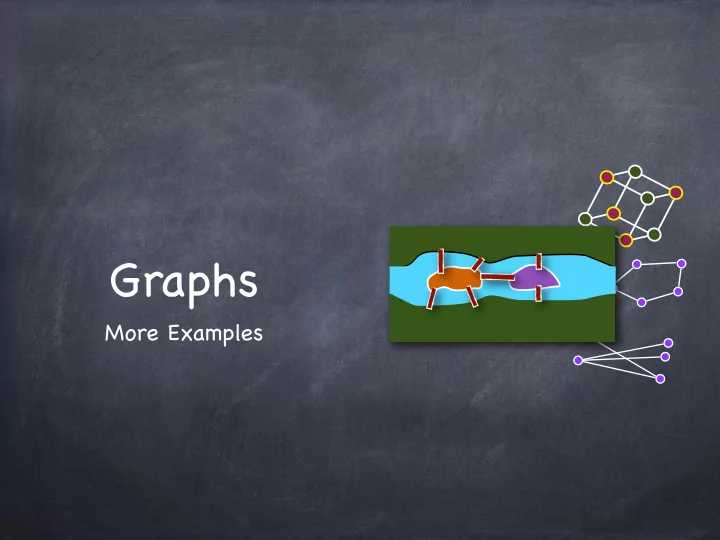

Graphs More Examples
More Examples
More Examples Path graph P n : V = {1,…,n} and E = { {i,i+1} | i ∈ [n-1] } Wheel graph W n (n ≥ 3) : V = {hub} ∪ Z n and E = { {hub, x} | x ∈ Z n } ∪ { {x,x+1} | x ∈ Z n } Ladder graph L n : V = {0,1} × {1,…,n}, E = { {(0,i),(1,i)} | i ∈ [n] } ∪ { {(b,i),(b,i+1) | b ∈ {0,1}, i ∈ [n-1] } Circular Ladder graph CL n : 2 additional edges {(b,n),(b,1)}
Hypercubes The hypercube graph Q n Nodes: all n-bit strings. e.g., {000, 001, 010, 011, 100, 101, 110, 111} Edges: x and y connected iff they differ in exactly one position i.e., x & y neighbours if toggling a single bit changes x to y e.g.: Q 0 Q 1 Q 2 Q 3 2 n nodes, but “diameter” (longest shortest path) is only n Q n is an n-regular bi-partite graph The two parts: nodes labeled with strings which have even parity (even# 1s) and those labeled with strings of odd parity (odd# 1s) “1Q 3 ” Q n-1 is a subgraph of Q n “0Q 3 ”
Kneser Graph {1,2,3} Instead of bit strings, nodes in Q n can be taken as 111 subsets of [n], with edges present between sets 110 101 011 which differ in a single element {1,2} {1,3} {2,3} Graph KG n,k has nodes at the k th level in Q n : 100 010 001 {1} {2} {3} i.e., subsets of size k Ø 000 Edge between subsets which intersect A clique in KG n,k : a set of subsets which intersect pairwise. E.g., { {n} ∪ S | S ⊆ [n-1], |S|=k-1 }, has C(n-1,k-1) nodes Erd ő s-Ko-Rado Theorem: If k ≤ n/2, then no larger cliques Kneser Graph KG n,k : Same as above, but with edges between subsets which are disjoint
Graph Operations Complement: Interchange edges and non-edges Given G = (V ,E), = (V G , ) E Union, Intersection, Difference, Symmetric difference: G 1 = (V ,E 1 ), G 2 = (V ,E 2 ), G 1 op G 2 = (V , E 1 op E 2 ) Union and intersection can also be defined for G 1 = (V 1 ,E 1 ), G 2 = (V 2 ,E 2 ) as G 1 op G 2 = (V 1 op V 2 , E 1 op E 2 ) Disjoint union: Union when V 1 ∩ V 2 = Ø Powering Given G = (V ,E), the square of G, G 2 = (V ,E’) where E’ = E ∪ { {x,y} | ∃ w {x,w},{w,y} ∈ E } More generally, G k has an edge {x,y} iff G has a path of length t ∈ [k] between x and y
Graph Operations Cross product If G 1 = (V 1 ,E 1 ), G 2 = (V 2 ,E 2 ), then G 1 × G 2 = (V 1 × V 2 ,E), where {(u 1 ,u 2 ),(v 1 ,v 2 )} ∈ E iff {u 1 ,v 1 } ∈ E 1 and {u 2 ,v 2 } ∈ E 2 e.g., G × K 2 is a bipartite graph Box product G 1 □ G 2 = (V 1 × V 2 ,E), where {(u 1 ,u 2 ),(v 1 ,v 2 )} ∈ E iff ({u 1 ,v 1 } ∈ E 1 and u 2 =v 2 ) or (u 1 =v 1 and {u 2 ,v 2 } ∈ E 2 ) e.g., Q m □ Q n = Q m+n e.g., Hamming graph (yields hypercubes for q=2) H n,q is K q □ ··· □ K q (n copies) Vertex set: [q] × ··· × [q] (n copies). Edge between (u 1, …,u n ) and (v 1, …,v n ) s.t. u i =v i for all but one coordinate.
Recommend
More recommend